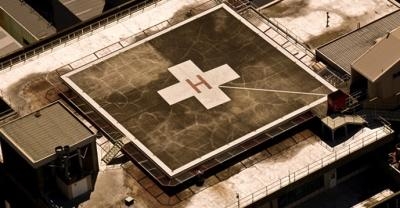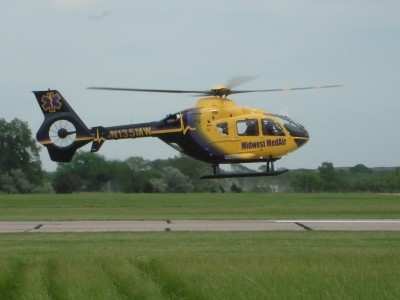Analyst Says LZs Are More Than Just Slabs Of Concrete Or Metal
The way hospital heliports are constructed may have an impact on patient morbidity and mortality according to a consultant to the industry.

An article first published in Waypoint AirMed & Rescue ... and reproduced here with the permission of the author, Rex Alexander, a 35-year-veteran pilot with over 28 years of military and commercial helicopter experience, 20 of which having been directly in the HEMS industry ... posits that all too often, hospital administrations and healthcare designers look at heliports as just another architectural structure to be squeezed into a location that has been deemed unsuitable for any other purpose1. Whether rooftop or ground based, heliports are much more than just a slab of concrete or metal. Heliports constitute a critical aeronautical environment for flight safety, but more importantly for hospitals, they represent a critical segment of patient care. This is in part due to the physiological effect that the air transport environment can place on both patient and crew. Stressors include, but are not limited to, vibration, barometric pressure, rapid acceleration and deceleration, gravitational
forces and temperature to name a few. Patient care in a helicopter versus a hospital setting is looked at by most air medical crews as a much more challenging environment when dealing with critically ill and injured patients.
Vibration is a fact of life in any patient transport. Vibration has been shown to interfere with patient assessment and some routine physiological functions. Depending on their amplitude and frequency, vibrations may facilitate bleeding and worsen the prognosis of patients with pelvic fractures. During helicopter transport, higher than average frequencies are generally more prevalent during acceleration, turns, and landing. At landing, rapid deceleration (the kind associated with poorly designed approach departure paths) has been suspected as the cause of a sudden rise in venous cerebral perfusion in neonatal patients, causing a potential risk of cerebral bleeding. Aircraft vibration has been shown to interfere with invasive and noninvasive patient monitoring, and in-flight vibration has also been shown to cause dysfunction of activity-sensing pacemakers.
An approach to a hospital helipad can be one of the most challenging segments of an EMS pilot’s flight, with hospital buildings, urban environments and nearby obstacles creating dangerous wind shifts, downdrafts, and turbulence. While we will never eliminate vibration in helicopter transport all together, we can definitely improve the heliport environment where turbulence induced vibration is most prevalent. To do this, we must pay particular attention to and understand basic aerodynamics, aircraft performance and the influence urban environments and buildings have on winds and wind patterns. Poorly sited and designed heliports represent a huge, albeit preventable, turbulence and vibration risk exposure to both patient and crew. Proper master planning in concert with early consultation from an experienced heliport safety expert has been proven to identify and prevent these types of issues well before they become a danger to both crew and patient.
Offsite heliports delay transport, which can have a significant impact on some patients and should be taken into account when selecting the most appropriate mechanism of patient transport and planning helipad construction. Handoffs between transport teams, transfers between modes of transport and delays in transport due to busy streets can greatly delay patient care. Additionally most pre-hospital care providers are not aware of whether a trauma center does or does not have a collocated heliport on its campus. Coupled with the additional ground ambulance transfers, which add additional risk exposure such as inadvertent extubation, pulled IVs, dropped patients, and caregiver back injuries, one can see that from a risk management standpoint, offsite locations can increase overall risk exposure to patients and staff exponentially.

Environmental extremes have been shown to be detrimental to a patient’s well-being. Exposure to extremes in temperature will result in an increased metabolic rate, causing increased oxygen demand and consumption. This may further compromise an already hypoxic patient. Excessive distances between the heliport and the hospital or the need for ground ambulance transfers from offsite facilities can increase environmental exposure times for patients. An additional concern for sites where a helicopter is based is for onboard medications to be subject to thermal abuse due to temperature extremes. Adequate master planning in advance of heliport site selection and construction can address these concerns well before they become dangerous risk factors for patients.
Access ramps are subject to numerous building and safety codes worldwide; however we continue to see excessively steep, narrow, and long transition areas with multiple unnecessary turns. The optimal patient transition route between heliport and hospital is one that is short, level, wide and straight while still adhering to the required (in the US) National Fire Protection Association (NFPA) life and fire safety codes found in NFPA-99, 101 & 41810. In making the area as level as possible, it makes larger patients, or patients requiring multiple and/or heavy medical devices such as a balloon pump, VAD or isolette, easier to move with less risk of damage to equipment or injury to the staff or their patients. Locations without dedicated patient ramps, including those where patients are moved between sites over parking lots and roadways, tend to be even more hazardous and detrimental to patient care since, in many cases, they are not required to meet the same code standards.
An additional concern is the potential for inadvertent increases in intracranial pressure for some patients as well as the possibility of decreased venous return – depending on head up/down and slope and length of time on ramps. While most stretchers are capable of elevating the head of the patient to accommodate the varying recommended patient positions, a patient secured to a backboard may not be able to have their head elevated as needed. Coupled with a long steep incline, this could have a very negative impact on some patients.
Heliport and access ramp surface conditions also play a major role in patient comfort and safety. Heliports and transition areas with multiple wide concrete seams, uneven pavement, rough surfaces, cracks and loose debris can cause jolts and vibration that induce excruciating pain for some patients as well as the potential for significant harm.

Alexander says that while he has identified some of the more significant risk factors associated with hospital heliports encountered during 20 years as an air medical helicopter pilot and heliport design and safety consultant, he has barely scratched the surface. In the end the ultimate litmus test for any hospital heliport must be ‘what is best for the patient!’ If air ambulance crews are lucky (and often times they aren’t), at some point in the design and planning phase of a hospital’s heliport, someone somewhere did a little research and discovered that there is a tremendous amount more to a heliport beyond just structural integrity and pouring a little concrete, and in turn was humble enough to seek out an experienced aeronautical consultant for help. There is, however, very little documentation that speaks to the recommended criteria for heliports as it relates to patient care. That, he says, only comes from experience.
 ANN's Daily Aero-Term (04.24.24): Runway Lead-in Light System
ANN's Daily Aero-Term (04.24.24): Runway Lead-in Light System ANN's Daily Aero-Linx (04.24.24)
ANN's Daily Aero-Linx (04.24.24) Aero-FAQ: Dave Juwel's Aviation Marketing Stories -- ITBOA BNITBOB
Aero-FAQ: Dave Juwel's Aviation Marketing Stories -- ITBOA BNITBOB Classic Aero-TV: Best Seat in The House -- 'Inside' The AeroShell Aerobatic Team
Classic Aero-TV: Best Seat in The House -- 'Inside' The AeroShell Aerobatic Team Airborne Affordable Flyers 04.18.24: CarbonCub UL, Fisher, Affordable Flyer Expo
Airborne Affordable Flyers 04.18.24: CarbonCub UL, Fisher, Affordable Flyer Expo





